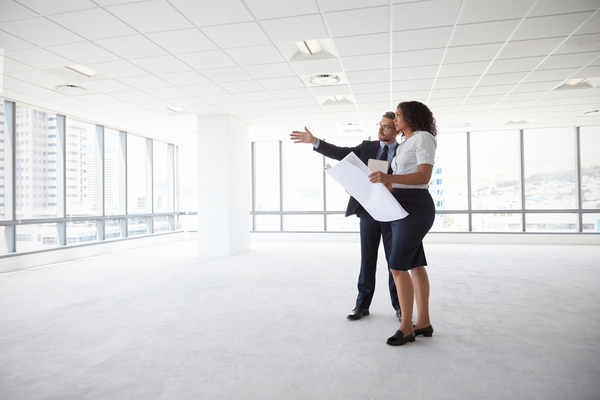After the 2020 peak of the coronavirus pandemic, the commercial real estate market is ready for positive change and growth. This year, we expect to see auspicious changes within office, retail, industrial, multifamily and colocation spaces. All of these rely on investor abilities to adapt their spaces and services using technology. In this two-part series we are sharing seven exciting insights for 2021 commercial real estate predictions based on CBRE’s and Deloitte’s Market Outlook reports. In this first part, we will cover the first three insights. Part two will be published on February 11.
Almost a year after shutdowns went into effect, many remote companies are still figuring out how to balance home and work life. With the coronavirus still looming in our everyday life, social distancing, thorough sanitization and virtual connectivity remain a top priority among investors. Not to mention, these are priorities to employers and employees. With vacancies and short-term tenancies abound, investors are looking for ways to increase the value and attractiveness of their assets. This is all while recovering losses from the previous year. In an effort to reduce inefficiencies, streamline processes and cut overhead costs, commercial real estate investors are virtualizing many in-person tasks. Such processes include the digitization and automation of property tours, access and security. Additionally, this helps with amenities and industrial jobs.
Commercial real estate companies will accelerate their use of technology within their assets to improve tenant experiences, overhead processes and building maintenance workflows. Such improvements include the integration of mobile apps and cloud-based tools. These will help improve tenant experience and assist property managers.

In 2020, we observed a multitude of businesses shift to remote workflows, with commercial office investors racing to keep up and offset torrential losses. For 2021 commercial real estate predictions, the modern office space stands between the crossroads of flexibility, functionality and quality. According to Deloitte, companies are “incurring higher operating costs because of the additional health and safety measures they are implementing . . . operating costs could increase by at least [$19.4] per square foot." This equals 5.8% of the average annual office rents at the beginning of 2020.
When it comes to 2021 commercial real estate predictions around office space, investors should be cautious. As vaccinations roll out and public fear of the pandemic diminishes, companies are rethinking how and when they will use office spaces. The lockdowns and shelter-in-place mandates of 2020 showed many companies their employees don’t need a full-time physical workplace. Still, companies realize they need a physical workspace to promote company culture, host innovation meetups and conduct critical face-to-face meetings. To future-proof their assets against long-term vacancies, investors and tenant companies alike will need flexible leasing terms. Ultimately, this means increased rent rates and short, shared lease terms.
Considering the shared nature of flexible leasing, offices need to be adaptable for use by a variety of companies. Investors are looking for new ways to maximize the use-case potential of their office spaces by creating simple, modular offices. If a commercial office investor wants to make the most use of his or her asset, they should aim to address the needs of multiple industries. But, these should include with accessible, shareable spaces.
In a time where remote work blurs the lines between work and home life, companies are also rethinking teamwork processes to design cohesive culture across remote teams. Among all the types of spaces, Class A properties will have the most demand for quality improvements. Commercial office investors can attract lessee companies invested in their employees' wellbeing. Typically, this can be done by enhancing their offices with modern, clean and premium amenities. After a pandemic, such features include:
Dense cities with tech firms like San Francisco and New York are expected to see a continued decrease in demand for office space since employees are working remotely and moving to more affordable areas. Despite the increase in remote employees, suburban commercial office usage is still expected to return to pre-pandemic normalcy as communities restabilize. However, urban areas will rebound at a slower pace than the suburbs. In order to stay relevant and desirable, office companies must present their locations as safe hosting options for team-building and collaboration across a variety of industries.
For 2021 commercial real estate, we expect to see commercial office space scale the quality and use-case potential of office spaces with a multifunctional design. The most notable changes in office space for 2021 concern future leasing flexibilities, rent increases (to compensate for flexibility and 2020 losses), and contactless technological amenities.
 Insight 3: Retail’s Mixed-Use Pivot
Insight 3: Retail’s Mixed-Use PivotThe most interesting commercial real estate evolving during this period is in relation to malls. Before 2020, many retailers were already shifting to e-commerce platforms. Additionally, malls were already undergoing a rapid decline in popularity. Then, the virus forced lagging retailers to adopt the e-commerce models or go out of business.
Malls are immensely promising commercial ventures for urban areas. However, converting them into mixed-use spaces requires a good amount of zoning law workaround. For investors, mall storefronts may need to adjust their usage to improve community engagement to combat the losses and costs incurred by storefront vacancies and rent drops.
For urban-dwellers, converting malls into community spaces like medical, grocery, recreation and cultural centers is an opportunity to address the growing demand for essential retail and housing, as well as create a safe gathering place to combat the isolation of social distancing. Some quick, adaptive features malls can put into effect immediately include:
There will be a decreased demand for retail space in dense cities and a moderate to large demand and growth for retail spaces in suburban areas. The difference in growth is largely due to the available amount of living space and population density.
Retail spaces in urban areas are expected to convert into essential retail storefronts within the next couple of years. With more room to spare, suburban areas should expect to see a natural rebound for all types of retail spaces, particularly experiential storefronts like shopping and dining throughout the year. There is no estimated timeline for malls to convert into mixed-use properties. Due to its complexity with zoning and local ordinances, it may be a long process that may outlast the hotel industry’s comeback (more on hotels starting at insight 6).
... Visit our blog again on February 11 to read the second half of this series. ...